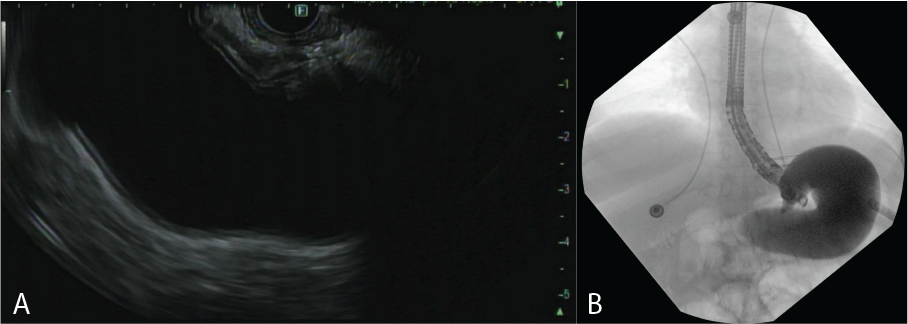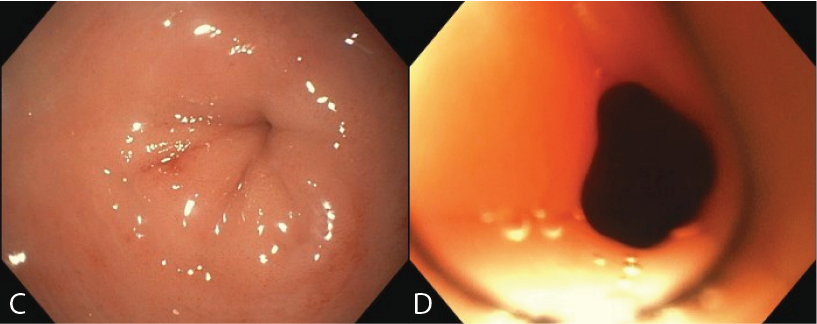Tuesday Poster Session
Category: Interventional Endoscopy
P5761 - Successful G-POEM via EDGE in a Post-Roux-en-Y Gastric Bypass Patient
Tuesday, October 28, 2025
10:30 AM - 4:00 PM PDT
Location: Exhibit Hall

Michael Bebawy, DO (he/him/his)
Rutgers New Jersey Medical School
Newark, NJ
Presenting Author(s)
Michael Bebawy, DO1, Kranthi Mandava, MD1, Rohan Karkra, MBBS1, Menna-Allah Elaskandrany, DO2, Gokturk Suut, MD3, Ahmed Al-Khazraji, MD1, Kaveh Hajifathalian, MD1
1Rutgers New Jersey Medical School, Newark, NJ; 2Lenox Hill Hospital, Northwell Health, New York, NY; 3Rutgers New Jersey Medical School, Montville Township, NJ
Introduction: Gastroparesis is a chronic gastric motility disorder that can be debilitating and difficult to manage, particularly in patients with altered surgical anatomy. Gastric peroral endoscopic myotomy (G-POEM) has emerged as a minimally invasive treatment option, but access to the pylorus is technically unfeasible in patients with Roux-en-Y gastric bypass (RYGB). Endoscopic ultrasound-directed transgastric ERCP (EDGE) using a lumen-apposing metal stent (LAMS), allows endoscopic access to the remnant gastric stomach to facilitate therapeutic interventions. We present what we believe to be the first reported case of a successful G-POEM via EDGE.
Case Description/
Methods: A 52-year-old female with obesity status post RYGP (2011) and revision (2021), diagnostic laparoscopy and lysis of adhesions (2022), presented with longstanding nausea and frequent regurgitation after eating. CT abdomen/pelvis revealed distension of the excluded gastric remnant without evidence of bowel obstruction. EGD was performed after EUS-directed transgastric gastrogastrostomy (EDGE) with Axios stent placement between pouch and remnant stomach. Contrast was injected into the remnant stomach during EUS; absence of contrast flow into the duodenum and afferent jejunal limb suggested likely gastric outlet obstruction contributing to her symptoms. EGD demonstrated resistance at the pylorus without visible stricture or mass. The patient subsequently underwent G-POEM via EDGE access. There was no resistance to scope passage post-myotomy, indicating excellent initial results. Follow-up EGD showed a healing myotomy and the AXIOS stent was removed. The patient reported symptomatic improvement with reduced regurgitation and improved meal tolerance.
Discussion: This case demonstrates the feasibility and safety of performing G-POEM via a matured EDGE tract in a post-RYGB patient. While EDGE is commonly employed for ERCP, its adaptation to facilitate myotomy is novel. This combined approach expands therapeutic options for gastroparesis in patients with altered GI anatomy, such as those with RYGB. A gastric emptying study cannot be performed in patients who have undergone prior Roux-en-Y surgery. However, in these patients, an endoscopic examination (EGD) that shows no mass or stenosis at the gastric outlet, along with contrast accumulation in the stomach during endoscopic ultrasound (EUS), may suggest the presence of gastroparesis.

Figure: Figure A – EUS demonstrating distended gastic remnant, Figure B – Fluroscopy demonstrating lack of post pylorus contrast

Figure: Figure C – Pre-POEM gastric pylorus, Figure D – Post-POEM gastic pylorus
Disclosures:
Michael Bebawy indicated no relevant financial relationships.
Kranthi Mandava indicated no relevant financial relationships.
Rohan Karkra indicated no relevant financial relationships.
Menna-Allah Elaskandrany indicated no relevant financial relationships.
Gokturk Suut indicated no relevant financial relationships.
Ahmed Al-Khazraji indicated no relevant financial relationships.
Kaveh Hajifathalian indicated no relevant financial relationships.
Michael Bebawy, DO1, Kranthi Mandava, MD1, Rohan Karkra, MBBS1, Menna-Allah Elaskandrany, DO2, Gokturk Suut, MD3, Ahmed Al-Khazraji, MD1, Kaveh Hajifathalian, MD1. P5761 - Successful G-POEM via EDGE in a Post-Roux-en-Y Gastric Bypass Patient, ACG 2025 Annual Scientific Meeting Abstracts. Phoenix, AZ: American College of Gastroenterology.
1Rutgers New Jersey Medical School, Newark, NJ; 2Lenox Hill Hospital, Northwell Health, New York, NY; 3Rutgers New Jersey Medical School, Montville Township, NJ
Introduction: Gastroparesis is a chronic gastric motility disorder that can be debilitating and difficult to manage, particularly in patients with altered surgical anatomy. Gastric peroral endoscopic myotomy (G-POEM) has emerged as a minimally invasive treatment option, but access to the pylorus is technically unfeasible in patients with Roux-en-Y gastric bypass (RYGB). Endoscopic ultrasound-directed transgastric ERCP (EDGE) using a lumen-apposing metal stent (LAMS), allows endoscopic access to the remnant gastric stomach to facilitate therapeutic interventions. We present what we believe to be the first reported case of a successful G-POEM via EDGE.
Case Description/
Methods: A 52-year-old female with obesity status post RYGP (2011) and revision (2021), diagnostic laparoscopy and lysis of adhesions (2022), presented with longstanding nausea and frequent regurgitation after eating. CT abdomen/pelvis revealed distension of the excluded gastric remnant without evidence of bowel obstruction. EGD was performed after EUS-directed transgastric gastrogastrostomy (EDGE) with Axios stent placement between pouch and remnant stomach. Contrast was injected into the remnant stomach during EUS; absence of contrast flow into the duodenum and afferent jejunal limb suggested likely gastric outlet obstruction contributing to her symptoms. EGD demonstrated resistance at the pylorus without visible stricture or mass. The patient subsequently underwent G-POEM via EDGE access. There was no resistance to scope passage post-myotomy, indicating excellent initial results. Follow-up EGD showed a healing myotomy and the AXIOS stent was removed. The patient reported symptomatic improvement with reduced regurgitation and improved meal tolerance.
Discussion: This case demonstrates the feasibility and safety of performing G-POEM via a matured EDGE tract in a post-RYGB patient. While EDGE is commonly employed for ERCP, its adaptation to facilitate myotomy is novel. This combined approach expands therapeutic options for gastroparesis in patients with altered GI anatomy, such as those with RYGB. A gastric emptying study cannot be performed in patients who have undergone prior Roux-en-Y surgery. However, in these patients, an endoscopic examination (EGD) that shows no mass or stenosis at the gastric outlet, along with contrast accumulation in the stomach during endoscopic ultrasound (EUS), may suggest the presence of gastroparesis.

Figure: Figure A – EUS demonstrating distended gastic remnant, Figure B – Fluroscopy demonstrating lack of post pylorus contrast

Figure: Figure C – Pre-POEM gastric pylorus, Figure D – Post-POEM gastic pylorus
Disclosures:
Michael Bebawy indicated no relevant financial relationships.
Kranthi Mandava indicated no relevant financial relationships.
Rohan Karkra indicated no relevant financial relationships.
Menna-Allah Elaskandrany indicated no relevant financial relationships.
Gokturk Suut indicated no relevant financial relationships.
Ahmed Al-Khazraji indicated no relevant financial relationships.
Kaveh Hajifathalian indicated no relevant financial relationships.
Michael Bebawy, DO1, Kranthi Mandava, MD1, Rohan Karkra, MBBS1, Menna-Allah Elaskandrany, DO2, Gokturk Suut, MD3, Ahmed Al-Khazraji, MD1, Kaveh Hajifathalian, MD1. P5761 - Successful G-POEM via EDGE in a Post-Roux-en-Y Gastric Bypass Patient, ACG 2025 Annual Scientific Meeting Abstracts. Phoenix, AZ: American College of Gastroenterology.
